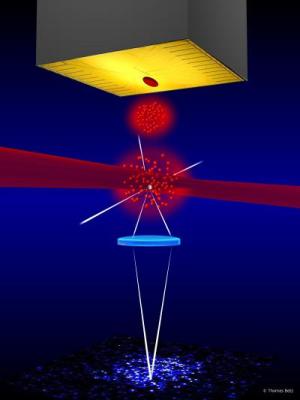Jun 6 2014
At TU Vienna, a new method was developed to utilize quantum mechanical vibrations for high precision measurements; The well-known concept of the Ramsey interferometer is applied to a complex multi particle system consisting of hundreds of atoms.
 Using the atom chip, the Bose-Einstein condensates can be controlled very accurately. Credit: TU Vienna
Using the atom chip, the Bose-Einstein condensates can be controlled very accurately. Credit: TU Vienna
Sometimes quantum particles behave like waves. This phenomenon is often used for high precision measurements, for instance in atomic clocks. Usually, only the wave properties of single particles play a role, but now researchers at the Vienna Center for Quantum Science and Technology, Vienna University of Technology have succeeded in quantum mechanically controlling hundreds of Rubidium atoms of an ultracold Bose-Einstein-condensate by shaking it in just the right way. Now, not only internal states of atoms can be used for interferometric measurements, but also the collective motional state of all particles.
Superpositions of Different States
According to quantum theory, some physical quantities can only have certain discrete values. If, for instance, the energy of an electron inside an atom is measured, it is always found in special energy states – other energy values are just not allowed. It is similar with the motion of particles, if they are confined to small spaces.
"We catch hundreds of Rubidium atoms in a magnetic trap and cool them so that they form an ultracold Bose-Einstein condensate", says Professor Jörg Schmiedmayer from the Institute for Atomic and Subatomic Physics at the Vienna University of Technology. "This Bose-Einstein-condensate moves as a gigantic matter wave." The laws of quantum physics, however, do not permit every kind of motion, but only a certain set of possible motion waves.
Different Wave States
"It is a bit like blowing a flute", says Sandrine van Frank. "When you blow it, a sound wave is created. If you blow it harder, you can produce a high-pitched overtone." In quantum physics, however, different states can be excited at the same time. With a precisely tailored electromagnetic pulse, developed in collaboration with Prof. Tommaso Calarco of the Institute for Quantum Information at the Univ. Ulm, the Bose-Einstein condensate can be shaken, so that it does not only occupy one of the possible motion states, but two at the same time.
Such a superposition of states is something quite normal in quantum physics. The amazing thing is that a system with hundreds of atoms and many degrees of freedom – in quantum terms something incredibly huge – can be prepared in such a superposition state. Usually, quantum superpositions are extremely fragile. The larger the object, the easier it is to destroy the quantum properties of a superposition of allowed quantum states – a phenomenon called "decoherence". Today, decoherence is considered to be the hardest problem for the development of new quantum technologies such as the Quantum Computer.
"After we have shaken the condensate with the pulse, it performs(exhibits) two different vibrational motions at the same time", says van Frank. "After a while, we shake the condensate a second time, recombining the two superimposed motions." Which of the two possible kinds of motion prevails in the end depends on the time delay between the two pulses and on the quantum phase of the superposition. Such a sequence of pulses is known as "Ramsey sequence" and is used for high-precision measurements in many areas. Now this technique was successfully transferred to the many-particle states of a Bose-Einstein condensate.
Just the Right Kick
In order to control the system, it was crucial to find exactly the right kind of pulse with which the condensate has to be shaken. It is supposed to enable a transition between the two vibration states that should be superimposed, but it should not be able to create any other possible states. Excluding all the other states turned out to be crucial for suppressing the unwanted decoherence effect.
"Our result proves that vibrational states of hundreds of atoms can be used for quantum experiments", says Schmiedmayer. These states can be used to store information, and one day maybe even to do calculations. The remarkable stability of these states also gives insight into decoherence phenomena of large systems, consisting of many particles – an extremely fruitful field of research. In a next step, not only vibrations but also rotation states of the Bose-Einstein condensate will be studied. In the quantum world, both are possible at the same time: shaken AND stirred.
This news release is available in German.